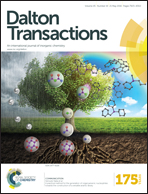Ferromagnetic interlayer interaction in KCo2Se2−xSx (0 ≤ x ≤ 2) and its chemical origin†
Abstract
Layered Co-based chalcogenides ACo2Ch2 (A = Tl, K, Rb and Cs; Ch = Se, S) are believed to adopt the ThCr2Si2-type structure and they all share a similar [CoCh] functional layer. However, their interlayer magnetic interactions show significant differences, with the underlying mechanism still unclear. In this work, the chemical origin of the magnetic interactions in layered KCo2Se2−xSx (0 ≤ x ≤ 2) solid solution has been investigated by experiments and first-principles calculations. All the members of this solid solution are found to have the tetragonal ThCr2Si2-type structure with the space group I4/mmm. Both a and c lattice constants shrink monotonously with S doping. Ferromagnetic interactions are the same for all the members, even for a member with a similar layer distance to those of the antiferromagnetic TlCo2Se2−xSx. The calculated band structure and density of electronic states of KCo2Se2−xSx and TlCo2Se2−xSx show dramatically different scenarios, which is mainly due to the nature of Tl–Ch and K–Ch chemical bonding. Compared with the Tl chalcogenides, the K counterparts with ionic K–Ch bonds present more localized electronic states in terms of energy, which leads to positive interaction constants in the RKKY model. Our results give the quantitative explanation of the different interlayer couplings in the ACo2Ch2 family, as well as the influence of the intercalating layer on the properties of the functional layers in the ThCr2Si2-type structure.


 Please wait while we load your content...
Please wait while we load your content...